Jon Brooks • • 23 min read
16 Mindfulness Pointers That’ll Reveal How Little Most People “Get It,” and a New Foolproof System for 24/7 Bliss
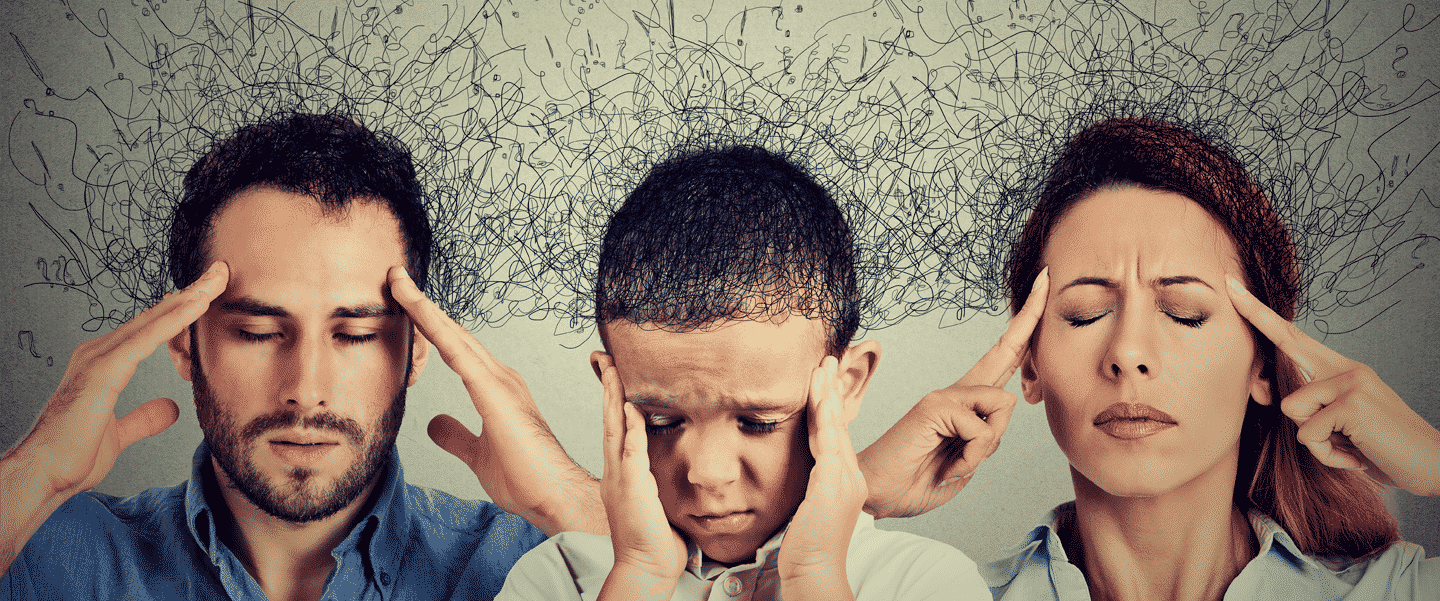
Meditation is bigger than ever, but there’s a problem…
A survey conducted in 20121, showed that approximately 8.0% of U.S. adults (18 million) had tried meditation, and that number is steadily growing with help from the tech world. The meditation app Headspace, the co-founder of which we will be hearing from shortly, has over 9,000,000 monthly subscribers — 18 percent of those pay for the service2. Calm, another popular meditation app, managed to raise over $1,000,000 in funding for its development.
People love to meditate with these apps, myself included. According to Founder and CEO of Calm, Alex Tew, about half launch the app daily, while many of the remaining users return regularly, like 8 or 10 times per month3. In a survey, 90 percent of Calm users suggested they would be “somewhat” or “very” disappointed if they could never use the app again.
But while the conversion of these ancient traditions into slick, instantly downloadable apps has made Eastern contemplative practices more accessible, there has been some wisdom lost in translation. For many people, meditation has become a vitamin for the mind, giving them a free pass to neglect the rest of their emotional diet and exercise regime.
A few months ago I was listening to Sam Harris’ Waking Up Podcast where he interviewed Joseph Goldstein, a renowned meditation teacher and author. In the Podcast, Joseph and Sam had a short exchange that highlighted a major flaw in my meditation practice and radically altered my thoughts about meditation thereafter:
Sam Harris:
I didn’t learn how to meditate until I sat my first ten-day retreat, and I think this comment has given people some cause for despair because my experience was that I got very into meditation. I was sitting really reliably an hour a day for a full year before I went off on the first retreat with you. And it wasn’t until maybe the fifth day of that retreat — somewhere around the midpoint — where I really connected to the practice in a way that I hadn’t before. And I remember the epiphany, presumably reasonably accurate, that I had just been thinking with my legs crossed in my daily practice for the previous year. An hour a day was insufficient for me to really drop down a level, within a mindfulness context, with continuity and sustained attention to see what I wasn’t seeing and to clearly see the difference between being lost in thought and not. Now I’m sure I was a hard case, but can you comment on that? Is that a common experience to feel like it’s not until you sit in intensive retreat that you really know what it is you’re supposed to be doing?
Joseph Goldstein:
I guess the question I would ask you, and I don’t know if you remember back then, but in that time before your first ten-day retreat, you mentioned that you were sitting pretty reliably an hour a day. The question would be: what were you doing the other 23 hours?
If you’re anything like me, you often think about how you might do the “right” meditation technique for the “right” amount of time, at the “right” time of day, with the “right” frequency. Perhaps you take your meditation very seriously: you have candles, incense, Buddha statues, and basu bells in your room, and perhaps in that room you experience states of peace. But unless you’re a monk, you will undoubtedly spend far more time off the cushion than on. But how much attention and mindfulness do you bring to those “other 23 hours”? To neglect the time spent in daily life as being inferior to the practice of meditation is the biggest mistake a meditator can make and, unfortunately, the most common.
Larry Rosenberg, author of Breath by Breath: The Liberating Practice of Insight Meditation, explains:
We have retreats, we have our meditation room, and then there’s everything else; which is dirty, noisy, rotten, and lousy. And we don’t want any part of it. Now we may say, “mindfulness all day long,” “mindfulness in every posture,” “be aware in everything that you do,” but it often becomes the biggest cliché in spiritual circles, and it’s obvious that we’re not doing it.
There are a lot of powerful quotes in the article like the one above, but this post is much more than a compilation of quotes. It is a mindfulness toolkit for radically changing your life. However, the teachings that follow are not so much a linear accumulation of ideas, as they are an exploration — a compendium, a resource, a choose-your-own-adventure guide — on how best we ought to live with greater awareness, clarity, peace, and wisdom.
That said, the article is split into roughly three sections. In the first part we will explore the philosophy and importance of living life with more mindfulness. The second part will showcase the mindfulness tips and tricks of five meditation experts. Finally, I will show you my personal mindfulness hacks, which I’ve been developing for the last two years, for maintaining supreme concentration throughout the day.
Why would you want any of this?
Sam Harris said on the Joe Rogan Experience:
The truth is, just having a concentrated mind — that’s not getting lost in thought — is just intrinsically pleasurable. It’s intrinsically blissful. It’s the emotional bass note of all the good drug experiences.
So now that I have your attention, let’s dive in.
The Three Components of Mind Training
Headspace co-founder Andy Puddicombe in his audiobook The Headspace Guide to Meditation and Mindfulness: How Mindfulness Can Change Your Life in Ten Minutes a Day says that mind training, as passed down from the ancients, had three components:
- The approach (philosophy)
- The practice (meditation)
- The integration (mindfulness)
“For meditation to really work, to get the very best from the techniques, it’s vital that all three components are present: how best to approach the techniques, how best to practice the techniques, and how best to integrate the techniques. … No one aspect of this jigsaw is more, or less, important than the next.
“Imagine you’re given a beautiful classic car to look after,” says Andy. The approach to meditation is like learning how to drive the car and read the signs on the road. The practice is servicing the car each day by letting the engine tick over at its own comfortable pace, while the car remains stationary and getting used to how it sounds and feels. Finally, the integration is when you actually use the car in everyday life. As Andy says, “…What good is a car if you never take it anywhere? And it’s the same with meditation. The purpose of learning meditation is not so that you can spend your life sitting on your backside with your eyes closed, but to integrate that familiarity of awareness into other areas of your life.”
To help us with the integration component of training the mind, below I will provide five different attitudinal shifts for including the fruits gained during meditation into everyday life, followed by some practical advice on taking your spiritual progress to the next level.
The Meaning of “Full Attention”
These words of the Buddha, if taken as seriously as they were intended, include as much wisdom and instruction on the art of living as any library full of modern-day self-improvement books:
Whether going out or returning, the yogi acts with full attention.
Whether looking ahead or looking around, he or she acts with full attention.
Whether bending an arm or straightening it, he or she acts with full attention.
Whether defecating or urinating, he or she acts with full attention.
Whether walking, standing, or sitting; whether resting or awake; whether talking or silent, he or she acts with full attention.
From a Buddhist perspective, becoming wiser is not so much about amassing tips for hacking your life as it is learning to flow with the natural unfolding of things, moment by moment, with full attention. This type of “full attention” is not to be confused with a rigid, unyielding laser focus. Another way to think of the Buddha’s use of “full attention” would be to describe it as “awakened knowing.” It’s an awareness plus the openness to learn from direct experience — the Buddha in so many words is telling us to live an examined life.

To begin integrating awakened knowing into everyday life, one can simply start by attempting to learn about oneself from direct moment-by-moment experience. You could, for example, pay attention to the way you feel indulging in certain habits such as eating, sleeping, having sex, and communicating with others. You could pay attention to the way you feel when you wear certain clothes, go to work, wake up early, gossip about people, or get insulted.
By approaching things with awareness and openness to learning, one’s life can be truly transformed. Seeing ourselves with full attention creates an internal momentum towards change that is far more powerful and longer-lasting than any external motivator.
In my own life, I learned recently that when I feel rejected my mind starts conjuring up images of junk food. By seeing this thought arise before it has gained momentum, a space is created around the behavior, giving me time to respond skillfully to my emotions. Whether I indulge in junk food or not will give me further insights: perhaps I choose to eat the junk food, then I might notice self-sabotaging behavior. Because the drives that we are not aware of are often the most destructive, by continuing to examine one’s life with full attention, many of one’s problems won’t get solved, but better — they will dis-solve.
The Dot-to-Dot Day
Andy Puddicombe writes in The Headspace Guide to Meditation and Mindfulness that the mindfulness momentum gained throughout the day can be compared to drawing a straight line. He instructs us to:
Take a blank piece of paper and try drawing a straight line very slowly across the page. Even if you’ve got a very good eye, my guess is that there’ll be at least a few wobbles along the way. If you haven’t got a steady hand, the wobbles might be considerably greater. Let’s say that this line symbolizes your continuity of awareness throughout the day. When you’re aware, you tend to have a sense of calm, of focus, of direction. And remember, even if you’re not necessarily experiencing a pleasant emotion, you’ll still have a sense of space around the emotions, some increased perspective, and some emotional stability. However, much like the line you drew across the page, for most people this idea of continuity of awareness tends to look very shaky.”

Andy explains a better approach:
“Now try imagining it a different way. This time imagine that the piece of paper has lots of very small dots on it, going from one side to the other. Each dot is very close to the next one on the page.

”Now try drawing the same straight line. My guess is it’s much easier now. All you have to do is focus on getting from one dot to the next. You don’t have to think as far ahead as the other side of the piece of paper, but just a few millimeters to reach the next dot. All of a sudden it’s not so difficult to draw a straight line. And if we continue the analogy of the line representing your sense of awareness (and therefore your emotional stability) throughout the day, then this is obviously very good news.”

Andy is not suggesting that we force ourselves to be vigilant for every moment of every day; he is suggesting that by including multiple mindful moments throughout the day, concentration throughout the day might just start to become constant and effortless.
We will explore various mindfulness exercises for dot creation throughout the day shortly, but what’s important for now is that, as Andy puts it, you start to, “think about meditation as the platform from which you’ll operate over the next twenty-four hours. That sense of calm will enable you to respond skillfully to situations if you can maintain your awareness.”
The Flow of Undistracted Non-meditation
Another way you could describe the time you spend outside of formal meditation practice, according to Joseph Goldstein, is that of “undistracted non-meditation.”
In his interview with Sam Harris, Goldstein said:
It’s really important to watch the commitment to being mindful throughout the day, because concentration comes about through the continuity of mindfulness. So it’s not so much an effortful focusing, but rather more a quality of being relaxed back into the moment to get right back into the Dzogen Vipassana framework. A Dzogen phrase that is used very often is undistracted non-meditation. So the non-meditation part suggests that effortless quality, settling back into a natural awareness. But often people forget the undistracted part. It’s about this continuity of relaxed awareness. So the question is really whether we’re considering our meditation to be the time that we’re sitting on the cushion, for however long each day, or we’re seeing it as practicing that quality of undistracted non-meditation throughout the whole day. And it’s that continuity that will lead to some stability.
When I first learned how to practice mindfulness and meditation, I would put a lot of effort into trying to pay attention to things. I figured that the harder I focused upon an object, the more magical my experience would be. As my studies into Buddhism deepened, however, I realized that there is not really such a thing as good meditation and bad meditation or good concentration and bad concentration. It’s far simpler. One finds themselves either distracted or undistracted, and most of the so-called magic that comes from being undistracted comes from the continuity of attention rather than the attention paid at any one particular point in time, but to get a solid continuity of awareness we must, as spiritual teach Eckhart Tolle suggests, place great emphasis on The Power of Now.
When it comes to attaining Enlightenment, there are two basic, opposing schools of thought. One group believes that we already are Enlightened but we are unable to fully realize and therefore embody this way of being. Another group believes that we are not Enlightened, but with hard work and dedication we can develop the mind in such a way as to gain access to this higher way of being. I believe both are correct.
We all have the ability to be undistracted right now in this moment, so we all have the ability right now to experience Enlightenment. But Enlightenment, as it is popularly understood, is a “state,” which exists outside of the vacuum of any fractional moment — we tend to say the Buddha was Enlightened, not that the Buddha was Enlightened for a moment, but the latter is actually closer to the truth: after his awakening, he was Enlightened for every moment of his life.
Andy Puddicombe explains Enlightenment beautifully in an interview with Lewis Howes:
There’s often this idea that happiness or Enlightenment or whatever you want to call it is this thing out there, over there, in some other place. What you start to realize when you practice intensively is that it’s actually moment to moment. Enlightenment, happiness, peace of mind, is here in this moment. If we experience this moment, not only now but in the next moment and the next moment and the next moment, then we have stability of Enlightenment, of happiness, of peace of mind. So if you have awareness 24/7, and it’s moment to moment, and you develop consistency and stability of that, then you always have what you always wanted, and it was always here all along.
Enlightenment, then, is both a category and a continuum. We can only ever be distracted or undistracted in any given moment, but the flow of those undistracted moments can last for a long time or a short time depending on one’s concentration. Meditation provides us with the perfect way to practice the art of concentration in hopes that this will help us to prevent the flow from getting interrupted so easily in daily life.
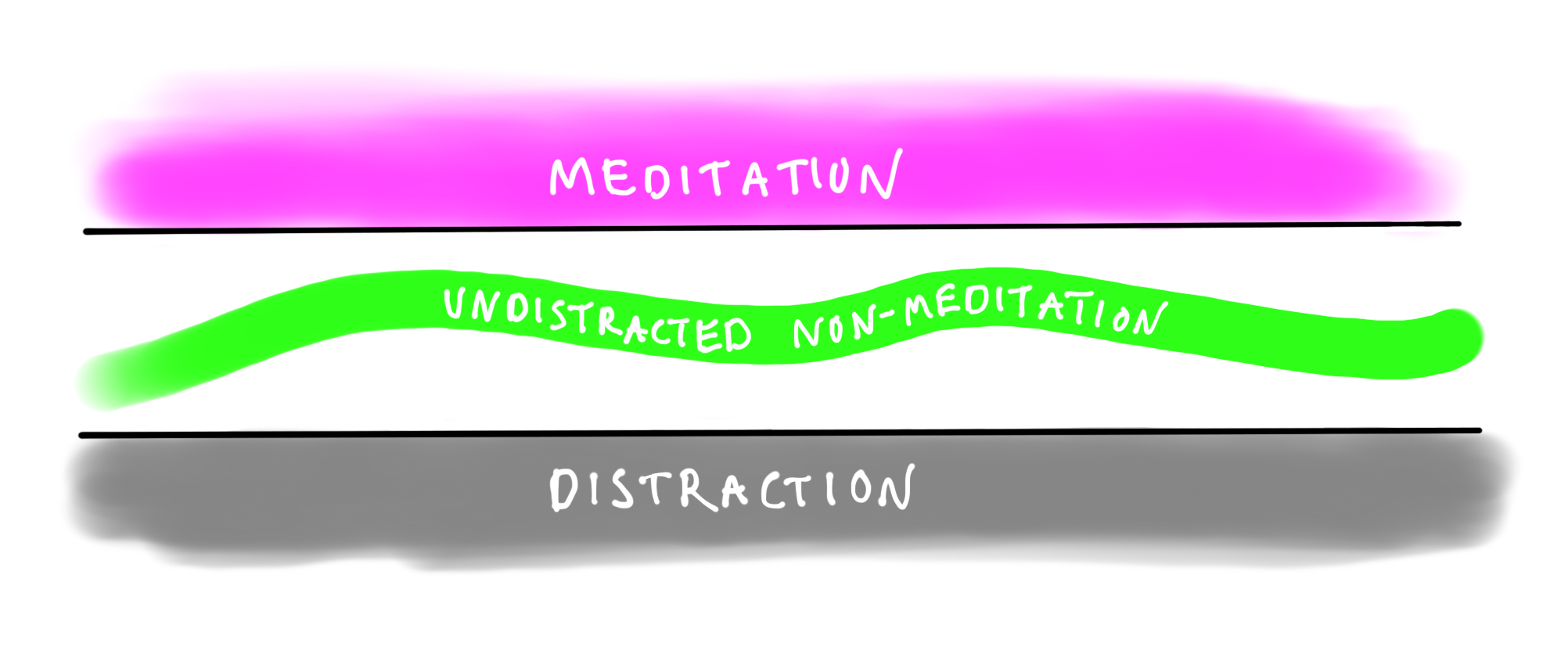
To lengthen your flow of undistracted non-meditation, you can simply ask yourself throughout the day, “Am I distracted?” If you are, you can return your gentle attention to the object before you. You may find when you do this, you are too distracted to even remember to ask “Am I distracted?” With persistence, repetition, and the techniques I’ll show you, however, this simple question can have profound effects on the quality of your day-to-day consciousness.
How to Practice Mindfulness of Breathing: The Salt and Pepper of Daily Life
Student of the Dalai Lama and renowned meditation practitioner B. Alan Wallace, Ph.D., wrote in his masterpiece Attention Revolution: Unlocking the Power of the Focused Mind:
Cognitive imbalances of both types can be remedied by applying to daily life the attention skills we cultivate during meditation. In fact, if we casually let our minds succumb to excitation and laxity throughout the day, there’s little change that our formal training during…is going to have much effect. This would be like eating a wholesome breakfast, then snacking on junk food for the rest of the day.
However busy we may be, or think we are, no one is paying us enough to have demands on our minds every single moment of the day. Even in the midst of work, we can take off fifteen-seconds here and sixty-seconds there to balance the attention by quietly focusing on the breath. Our eyes can be open, and we can sit quietly for a few moments, without calling attention to ourselves. We can do this in the workplace, while standing in line at the grocery store, or while waiting at a stoplight. There are many brief occasions from the time we get up in the morning until we fall asleep at night when we can “season our day” with a sprinkling of mindfulness of breathing. And each time we do it, we may immediately feel the soothing effect on our bodies and minds. In this way, we can begin to integrate the quality of awareness that we cultivate during meditation with the awareness that we bring to our activities in the world throughout the day.
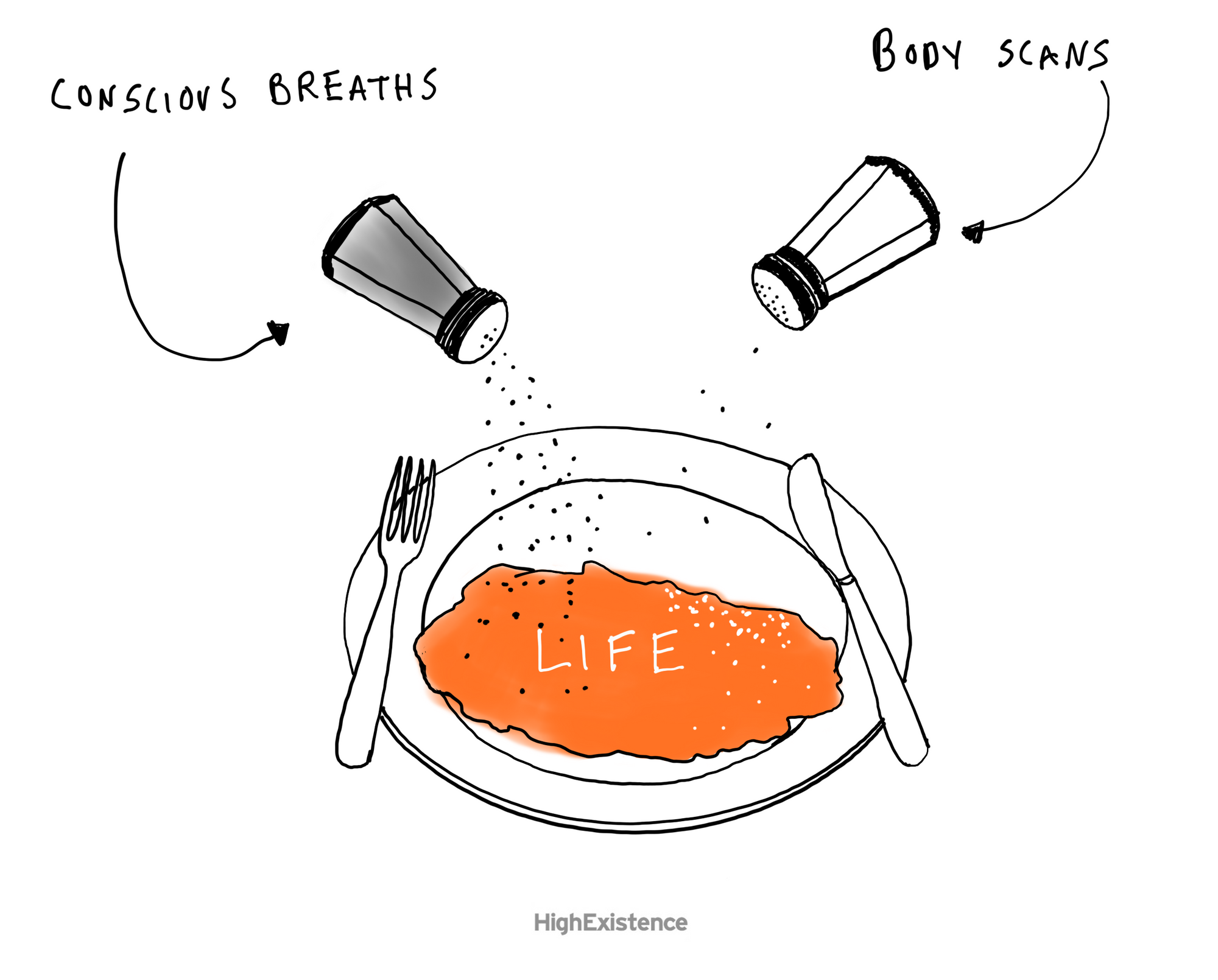
Wallace is suggesting that if we “season our day” with conscious breaths, we will be better able to integrate the awareness cultivated during our meditation sessions into our life. I will have more to say on when we ought to implement these breaths at the end of the post in the section entitled “Location-based Reminders.”
30-Day Mindfulness Challenges
At HighExistence, we really value the power of 30-day challenges to create meaningful transformations in our lives. We can do nearly anything for 30 days as Matt Cutts says in his TED talk. This time frame allows us to put a concentrated and high-quality effort because we know that at some point in the future the challenge will end.
Larry Rosenberg said in one of his Dharma talks:
With an attitude of learning, everything becomes a challenge rather than an obstacle. It’s a totally different way of looking at life. A challenge is something very positive. In fact, the deeper the challenge, the deeper it can take you into yourself. It can release all kinds of captive energies; all kinds of creativity. It can release blocks so that it will be welcomed even though they may be uncomfortable.
We created a philosophical challenge course called 30 Challenges to Enlightenment, which is full of various meditation challenges as well as challenges specifically designed to help one integrate mindfulness into every day life. Below is a sample of such challenges:
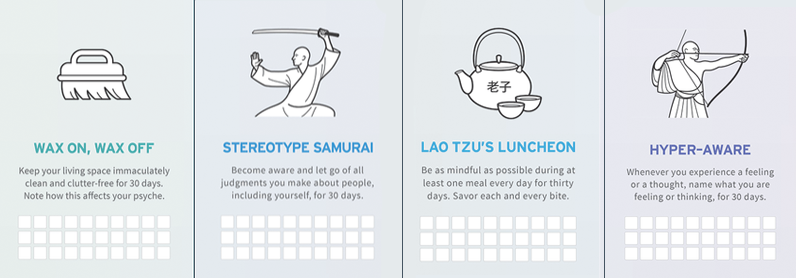
If one pays attention to a particular part of one’s life for 30 days in a row, that type of attention is likely to become part of one’s day-to-day interaction with the world.
Life is Not Separate From Meditation
Larry Rosenberg, has spent many years going in and out of monasteries and retreats and is the founder of Cambridge Insight Meditation Center. But Larry likes to challenge the superiority of the monastic way of life. He doesn’t even consider himself a Buddhist. He says that sex, food, and money are very powerful energies, and very few people know how to handle them. In the monastic tradition they deal with these energies by giving them up, but that’s just one human solution to a human problem.
While the monastic life can be helpful for some people, Rosenberg argues that it is not a prerequisite for enlightenment because many monks do not attain enlightenment and many non-monks do. The key, then, is starting from wherever one is, working with whatever one has — to do away with the concepts of right and wrong; inferior or superior — and pay full attention to whatever is unfolding.
Rosenberg writes in Breath by Breath:
We practice different forms—sitting, walking, retreats themselves—but before any form, before Buddhism or the Buddha—is life itself, waiting to be lived. Life is the real teacher, and the curriculum is all set up. The question is: are there any students? No form is unique, and on the other hand, every form is—sitting, walking, taking out the garbage, talking to a friend. Every form is unique, and so is every moment. When we see that, we are beginning really to practice.
I don’t feel that going out to the kitchen to cook my dinner is inferior to sitting. Talking to my wife is certainly not inferior. Going to the bathroom is not inferior. These things are all just life in that moment. Look with naive eyes and you will see that life is just one such thing after another. Practice isn’t part of life. Practice is life. And life is practice.
Below, you’ll find some simple but useful suggestions Rosenberg suggests for integrating mindfulness and blurring the lines between Meditation and Life:
5 Tips For Learning How to Practice Mindfulness In Daily Life from Larry Rosenberg
- When possible, do just one thing at a time.
- Pay full attention to what you’re doing.
- When your mind wanders from what you are doing, bring it back.
- Repeat step three, several billion times.
- Investigate your distractions.
Putting it All Together: The Methods I Use to Practice Mindfulness In Everyday Life
Untill now I’ve basically repeated the same simple message in multiple ways: try to be mindful in every moment. Because of the hard-to-grasp nature of spiritual teachings, I hoped that by sourcing different teachers and examples there would be a higher likelihood that the information would connect with you.
But as is often the case with spiritual advice, we may think that by accumulating more of it, we will progress further. But insight is actually not something that is accumulated from the outside world. Wisdom comes from the seeing, with awakened knowing, of mind, impermanence, suffering, self.
If we take the advice in this article seriously, we could potentially attain enlightenment, or at the very least experience life-changing benefits. But, unfortunately, most of us will not, mainly because we confuse information with insight. If, after reading this article, you switch to the next spirituality blog post or book to accumulate more information on spirituality, you are missing the point of the Buddha’s teaching.
The lesson is simple: “Whether walking, standing, or sitting; whether resting or awake; whether talking or silent, he or she acts with full attention.” You need nothing other than an internal commitment and discipline to practice this teaching, and that also includes the discipline to stick with the same thing — the practice of paying attention and waking up from distraction in an endless series of beginnings — over and over again for the rest of your life.
If you are committed to being more aware in everyday life, below I’ve listed the four ways I remember how to practice mindfulness. These are all methods I’ve developed in the personal laboratory of my life. I don’t think I’ve ever come across such a systematic approach to practicing mindfulness throughout the day, so I hope you find value in it.
Like learning any new skill, repetition is paramount. I recommend you practice one of these at a time. Spend a week on each, and you’ll have them all internalized within a month.
How to Practice Mindfulness in the Age of Distraction: The Five-fold Path
1) Timed reminders
Mindfulness reminders that are set up ahead of time on digital devices.
Phone alarms
According to B. Alan Wallace, seasoning the day with a few mindful breaths and body scans will go a long way to strengthening our flow of undistracted non-meditation. When I first read Wallace’s advice I tried it out, but would often forget to follow it. The paradox of practicing mindfulness is that we have to be mindful in the first place to practice it: the moment we realize we are distracted, we are not distracted.
I got around this dilemma by setting up mindfulness alarms on my phone. I downloaded an app called Alarmed and set 20 alarms, 35 minutes apart.
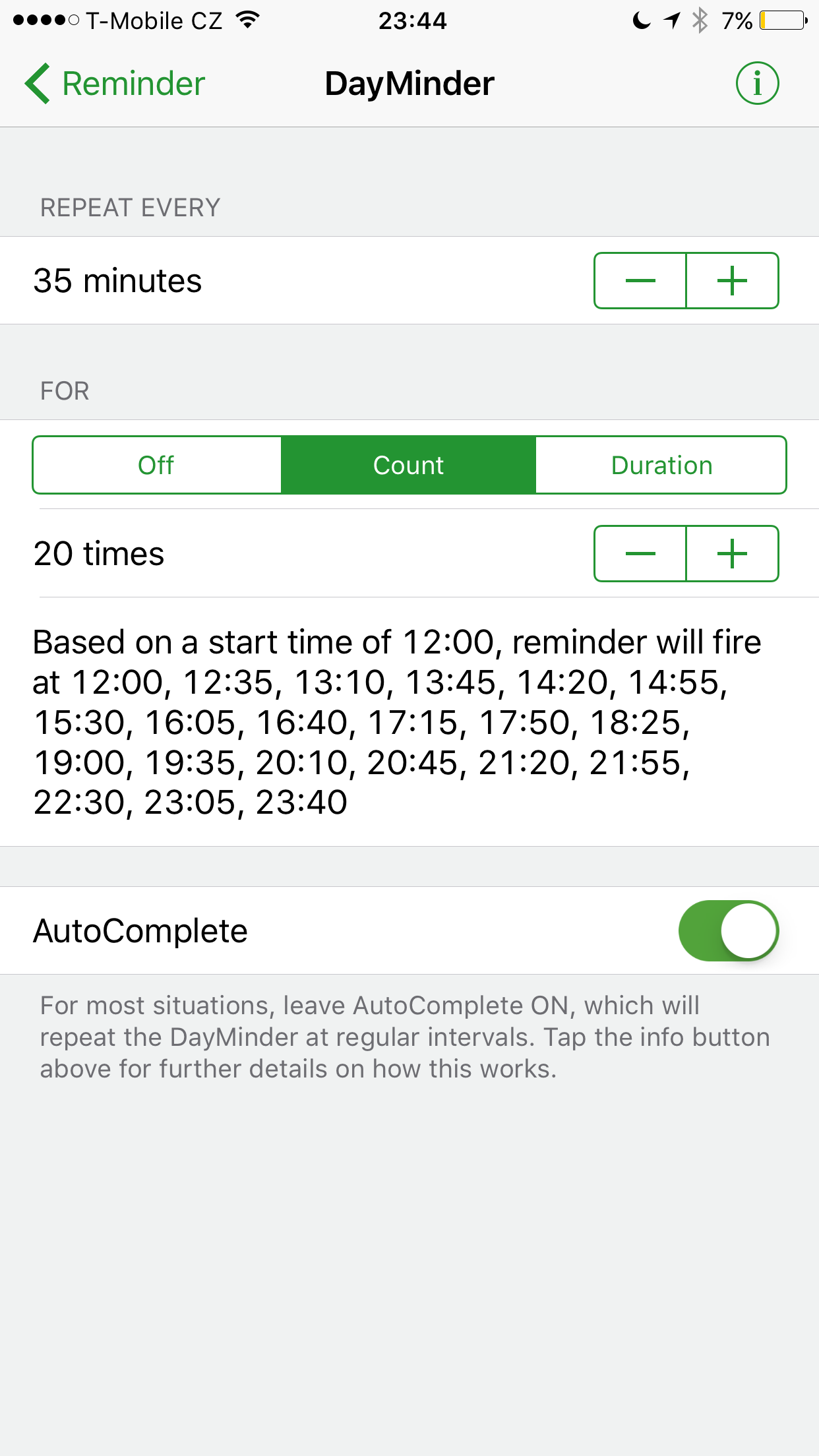
I set the text to the following instruction:
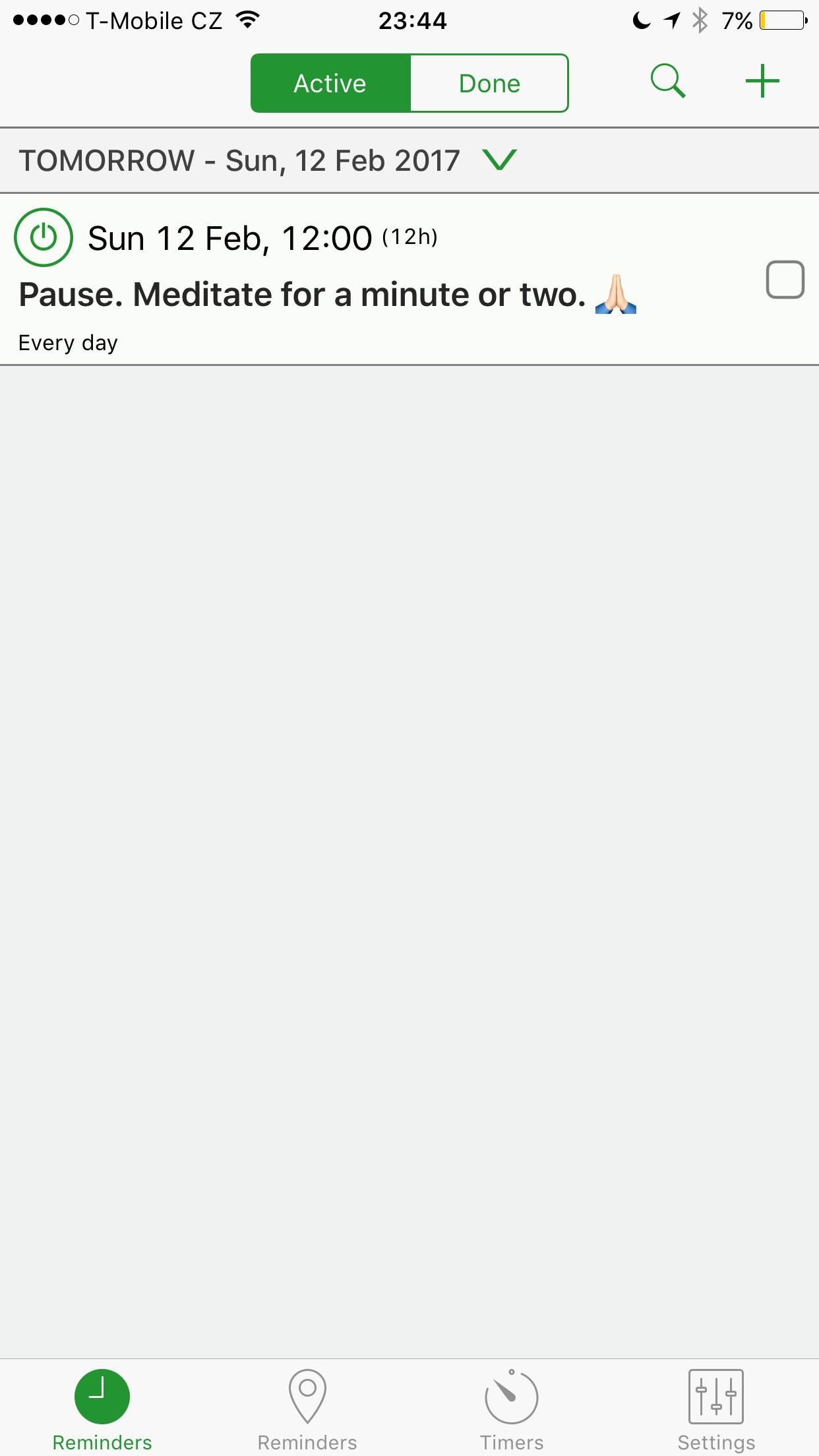
Whenever I received this timed reminder on my phone, I would open the Calm app and do 1-2 minutes of breath meditation. You can experiment with different apps and use different meditation intervals and lengths. The most important thing is that you take the reminders seriously and follow them no matter where you are or what you’re doing. If you happen to be caught up with something quite engaging, you can at the very least take three deep breaths.
Pomodoro technique
Have you ever noticed how hard it is to stay mindful online? The internet seems to absorb our consciousness to such an extent that we forget we are embodied beings. When I work online, I use the pomodoro technique: I use a timer app to help me work in 25-minute intervals with 5-minute breaks in between. You can use the short breaks between your work intervals to do some conscious breathing. The benefits of doing this cannot be overstated. A concentrated mind is not just a happy mind, it’s also a productive mind.
2) Location-based reminders
Mindfulness reminders that are triggered by cues in your environment.
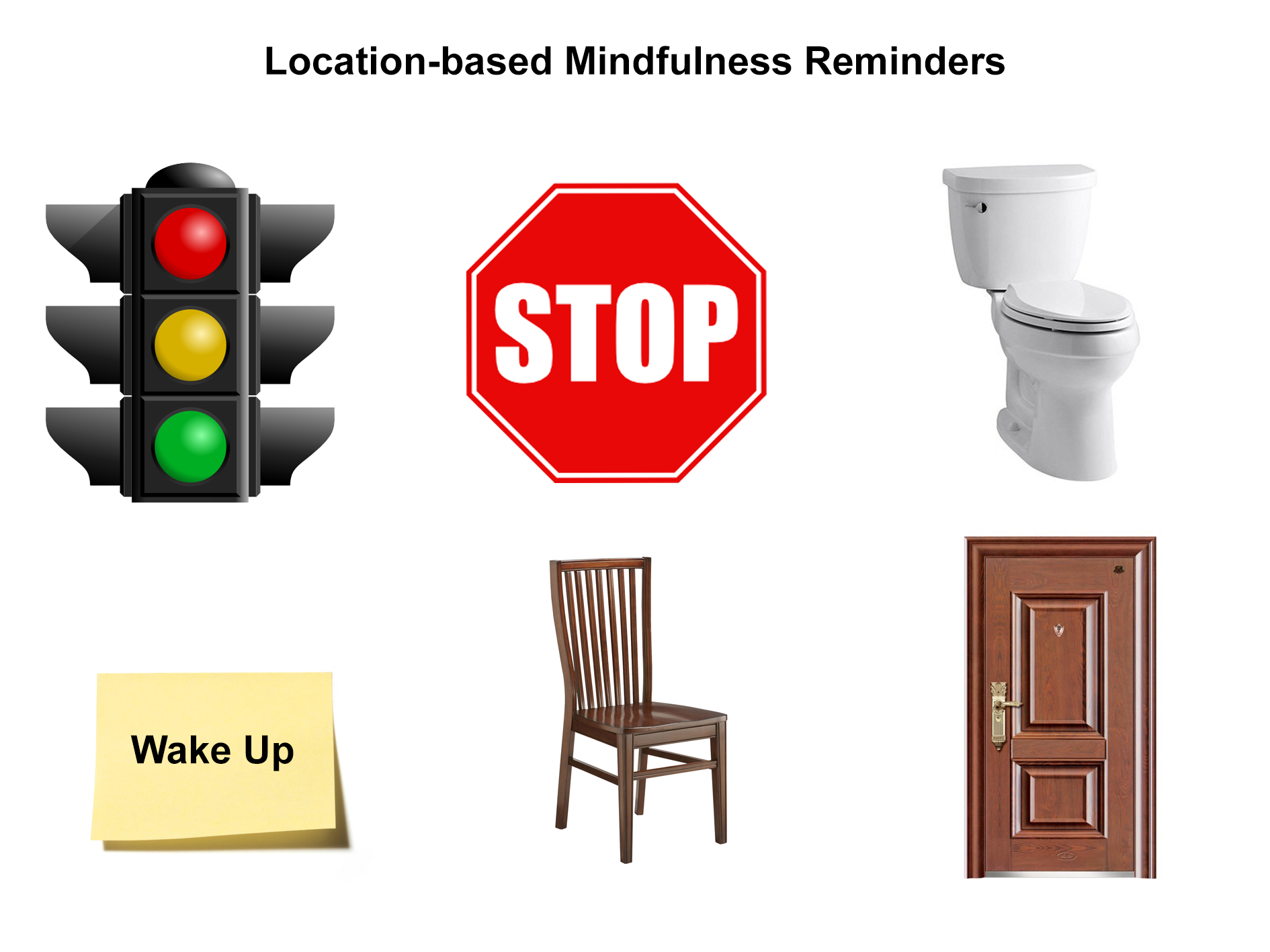
Here you want to link certain locations or landmarks with the act of waking up and paying attention. For example, every time you come to a red stop light while driving, you can take three conscious breaths (salt and pepper).
One of my favorite location-based reminders is to put post-it notes with the words “Wake Up” written on them around the house. Make it a rule to always ask yourself upon seeing them, “Am I awake?” Then clarify your intention for what you plan on doing next.
You can get as creative as you like with location-based reminders, but I would recommend starting with just a few locations or landmarks that you’re likely to see often and bring a focused mind to them.
3) Implementation intentions
Mindfulness reminders that are connected to pre-existing habits.
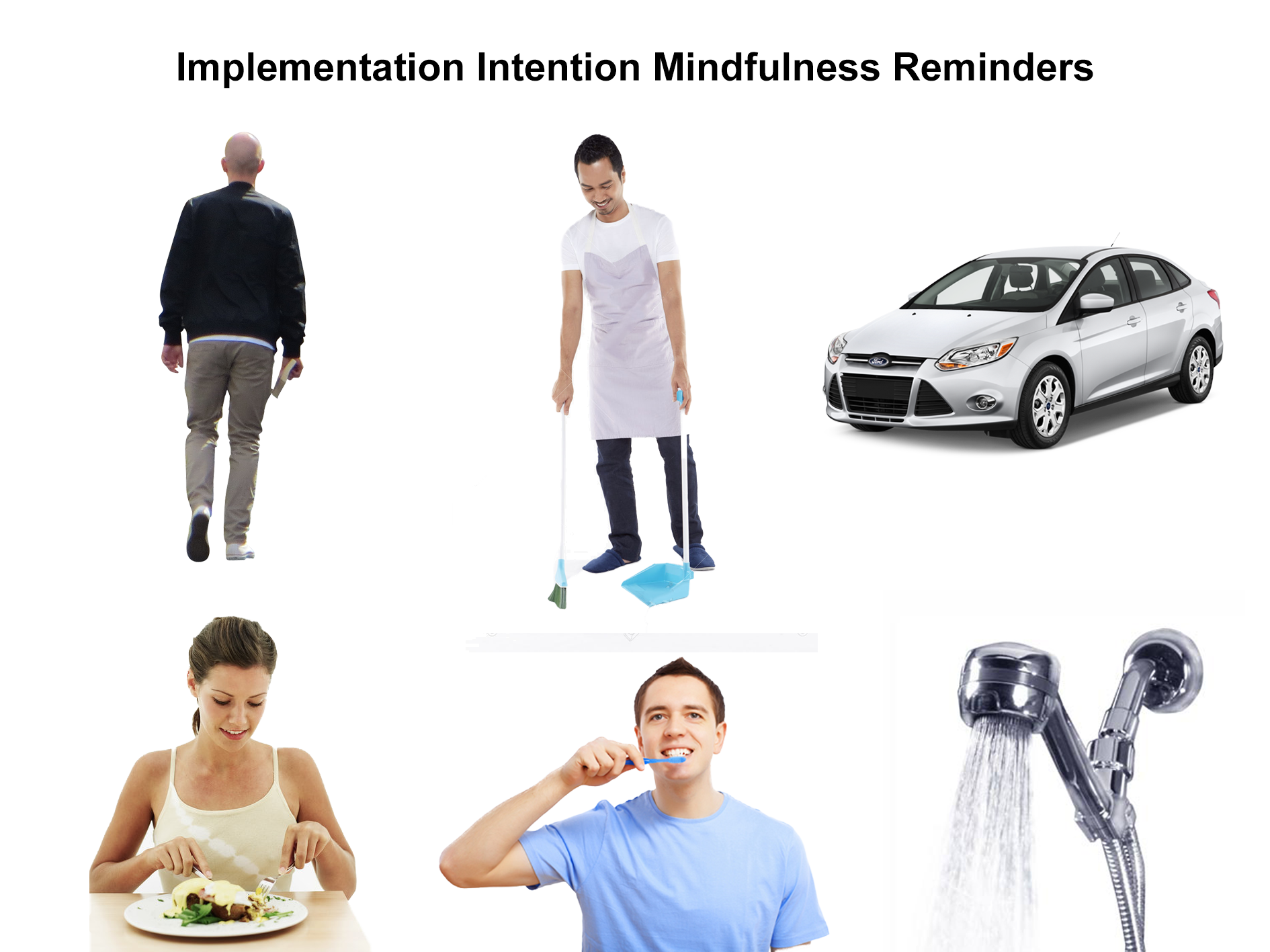
I learned about implementation intentions in the book Solving the Procrastination Puzzle. The idea is simple: link an existing habit with a new habit you want to cultivate.
“When I do X-Old-Habit, I will immediately do Y-New-Habit.”
If you struggle with keeping a daily meditation ritual, for example, you could link it to your first cup of coffee of the day.
“When I finish my first cup of coffee, I will do twenty minutes of meditation.”
The activity can become the meditation itself, all you have to do is pay attention to what it is you’re doing. I’m living in Prague right now, and one of my favorite implementation intentions for practicing mindfulness is stepping out of my apartment and walking to my first destination, usually a coffee shop.
“When I leave my apartment, I will take a few deep breaths, ground my awareness in my body, and walk while paying full attention to my body and surroundings for the entire duration of my walk to the coffee shop.”
Nearly any activity can be turned into a meditative practice, so have fun experimenting. A good place to start, however, would be the following activities:
- Walking meditation
- Commuting/driving meditation
- Eating meditation
- Brushing teeth
- Showering
- Household chores (sweeping the floor)
I’m not going to cover the techniques for walking and eating meditation in this article, but you can learn all about them in Andy Puddicombe’s book The Headspace Guide to Meditation and Mindfulness: How Mindfulness Can Change Your Life in Ten Minutes a Day (the audiobook version, which Andy narrates, is amazing).
In 30 Challenges to Enlightenment, if you remember, we also included challenges on mindful eating, tidying up, and showering.
4) High-Energy Reminders
Mindfulness reminders that come from emotionally arousing situations.
It’s common practice in monasteries to use bells during meditation to help remind people to bring their attention back to their chosen object. High-energy reminders are life’s meditation bells.
Whenever something gives you energy, whether good or bad, you can use it as a gift to bring you back to the present moment. For example, if you hear the telephone ringing, you can listen to it ring mindfully three times before you answer it. If you hear a loud and obnoxious police siren as you’re walking down the street, you can use the energy you get from it to “wake up” and come back to whatever is unfolding in your awareness. High-energy reminders include anything that makes you feel strongly about anything. You don’t have to put a positive or negative label on it. If you feel strong emotions toward something, even for just a moment, it can be used a reminder to come back to the present.
Examples:
- Phone notifications
- Dogs barking
- Emergency Sirens
- Strong emotions (anger/fear/anxiety)
5) Track “Mindful Minutes” on Streaks
Combining meditation and mindfulness in the same tracking app.
Quite recently, Apple Health has added mindfulness to their list of health sources one can track on Apple devices. This means when you meditate with supported apps (Headspace, Calm, and Insight Timer), your mindfulness data will be recorded in one place.
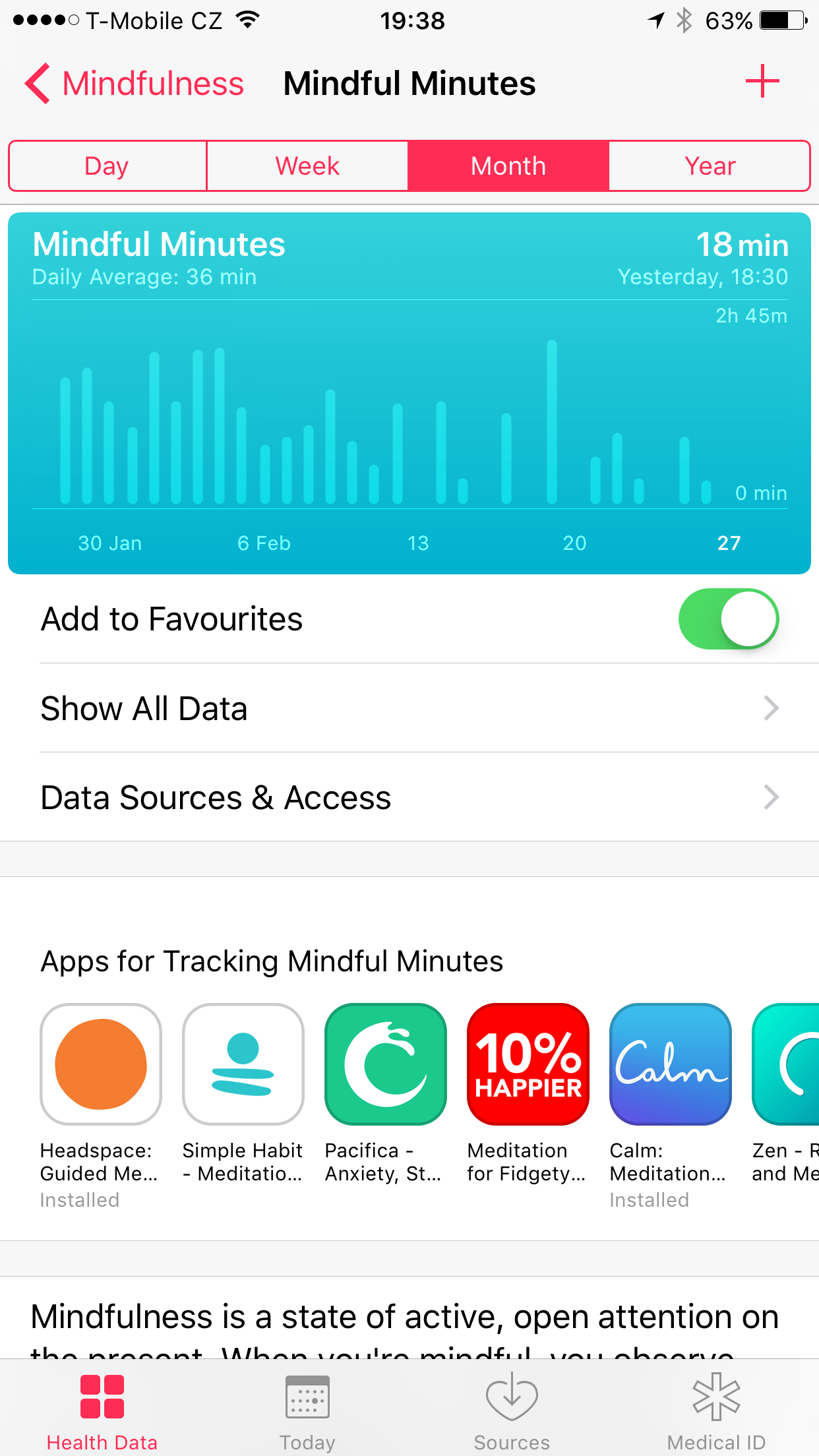
You can then also download an app called Streaks, which syncs up to Apple Health to help you hit your mindfulness goals. I use Streaks to track my mindfulness and meditation time in the same place. This way I don’t separate meditation from mindfulness. I track my formal meditation practice each day, but I also track mindful walks and the short meditations I do with the timed reminders above.
Of course, I don’t track all of the mindful minutes I do throughout the day, but I find this app extremely helpful for placing emphasis on both mindfulness and meditation.
If you plan to use Streaks to track your mindful minutes, I suggest you take for your goal twice as much time as you spend meditating each day. If you meditate for 30 minutes each day, set your mindful minutes goal as 60 minutes. This will amount to 30 minutes of meditation and 30 minutes of focused mindfulness practice.
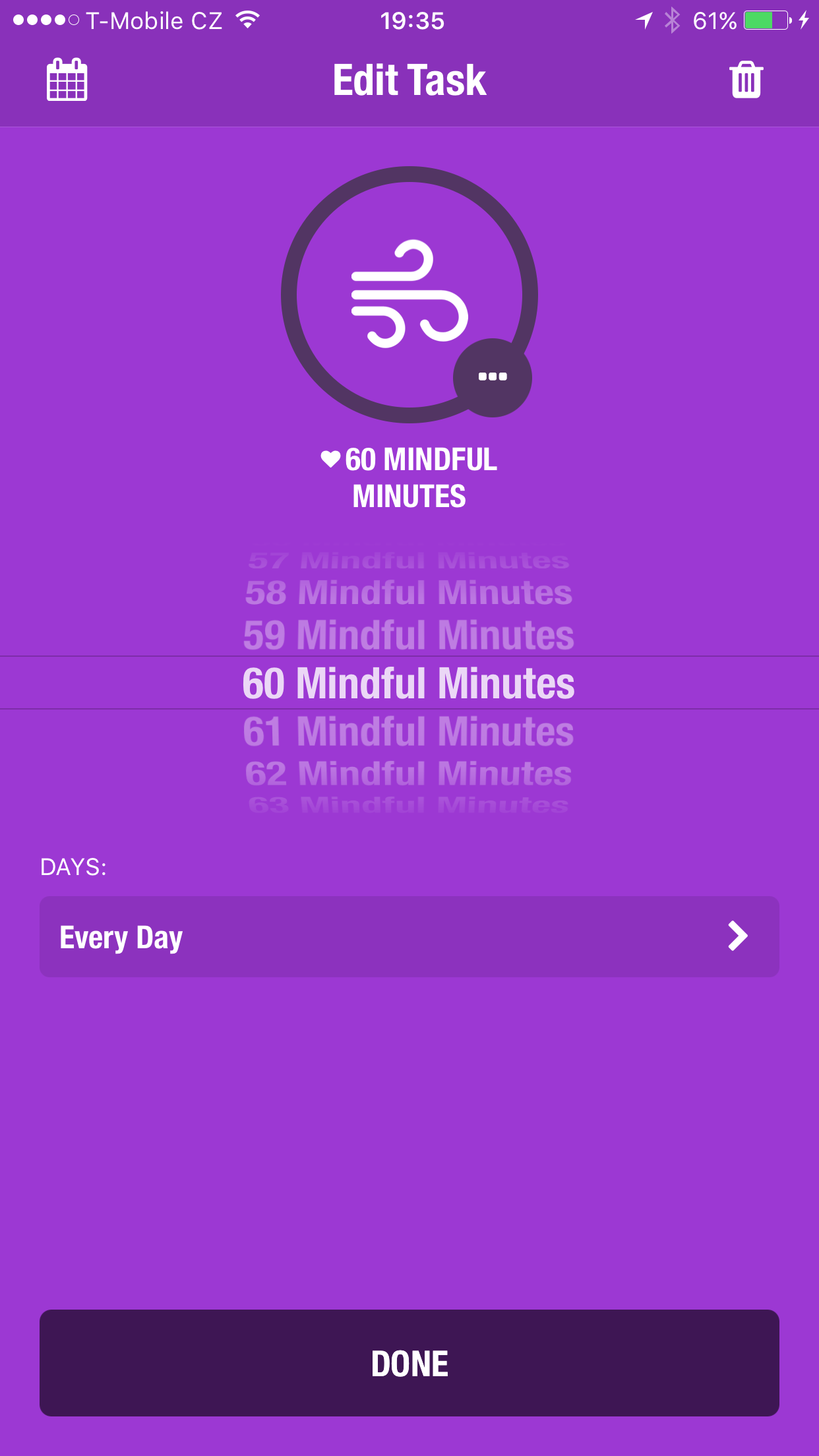
Final Note: Only Practicing Mindfulness is Not Enough
Throughout this article, I have stressed the importance of not over-valuing the time spent during meditation and under-valuing the time spent in daily life. To be clear, this does not mean that meditation should not be practiced. Meditation is an incredibly powerful tool for cultivating wisdom and tranquility, in fact one of the most powerful tools we have.
If you remember earlier, I mentioned the three components of mind training (approach/practice/integration). All three are of equal importance. In my mind, I compare the three components of mind training to living a healthy lifestyle: the approach would be to cut down on damaging lifestyle factors such as smoking and drinking, the practice would be going to the gym and exercising each day, and the integration would be eating a nutritious diet. To live the longest, healthiest life we can, all three components must be taken seriously.
Andy Puddicombe writes:
“Meditation is undoubtedly a vital cornerstone to the practice of mindfulness. To practice mindfulness in everyday life without doing even ten minutes of meditation a day is a bit like trying to build the foundations of a house on loose gravel. It will work, but it will not be anywhere near as stable as if you built it on solid ground.”
A personal challenge from the author
If the ideas in this post resonated with you at all, I have a challenge for you. For the next month, I challenge you to do the following:
- Meditate for at least ten minutes each day
- Pick at least three location-based mindfulness reminders
- Pick at least two implementation intention mindfulness reminders
- Salt and pepper your day with mindfulness
- See obstacles as challenges
- Make a ton of mistakes, but begin again
- And again…
Confucius once said, “I hear and forget, I see and I remember, I do and I understand.”
What will you do?
Recommended Resources for Deepening One’s Understanding of Mindfulness and Meditation:
- 30 Challenges to Enlightenment (Course)
- Breath by Breath: The Liberating Practice of Insight Meditation by Larry Rosenberg (Book)
- Three Steps to Awakening: A Practice for Bringing Mindfulness to Life by Larry Rosenberg (Book)
- The Headspace Guide to Meditation and Mindfulness: How Mindfulness Can Change Your Life in Ten Minutes a Day by Andy Puddicombe (Audiobook)
- The Power of Meditation with Andy Puddicombe and Lewis Howes (Video)
- The Attention Revolution: Unlocking the Power of the Focused Mind by B. Alan Wallace (Book)
- Mindfulness: A Practical Guide to Awakening by Joseph Goldstein (Book)
- Mindfulness, 25th anniversary edition by Ellen J. Langer (Book)
- The Power of Now: A Guide to Spiritual Enlightenment by Eckhart Tolle (Book)
- Sam Harris and Joseph Goldstein Conversation | Part 1 | Part 2 | Part 3 | (Audio)
- Larry Rosenberg’s Dharma Talks (Audio)
- 26 Scientific Benefits of Meditation (Article)
- How to Deepen Your Meditation Practice (Article)
- Zen Grasshopper section of the 30 Challenges to Enlightenment Guidebook (Free Book Download)

Jon Brooks
Jon Brooks is a Stoicism teacher and, crucially, practitioner. His Stoic meditations have accumulated thousands of listens, and he has created his own Stoic training program for modern-day Stoics.










